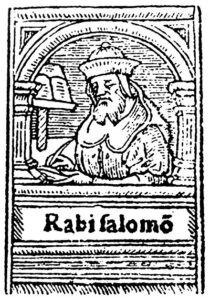
(Illustration: Wikipedia)
Rashi (Feb. 22, 1040-July 13, 1105) was born in Troyes, Champagne, France, as Shlomo Yitzhaki, the son of Yitzhak. The name of his mother has not come down to us, but it is known that she was the sister of Rabbi Simeon bar Isaac, the rabbi of Mainz. “Rashi” is an acronym of his name Rabbi Shlomo Yitzhaki. His fame as a commentator on the Hebrew Bible and the Talmud was so great that numerous legends were told about him.
One legend said that his father Yitzhak found a precious jewel which two non-Jews wished to purchase to adorn their idol. Rather than sell it to them, he threw the gem into the sea. Either the Voice of God or the Prophet Elijah then told him he would be rewarded with the birth of a noble son who “would illuminate the world with his Torah knowledge.”
Another legend said that when Rashi’s mother was pregnant, she was walking down a narrow street in the Jewish quarter of Worms, Germany, when two carriages coming down the street forced her to press herself against a wall. The wall opened up to receive her, forming a niche that still is visible in the wall of the Worms synagogue.
Yet a third legend said that Rashi’s work was directly influenced by the Shechinah, one of the aspects of God. One version of that legend was that Rashi didn’t die, he was transported to heaven alive, just as the prophet Elijah was.
Tradition teaches that Rashi started learning at the age of 5 from his father. He married at age 17 and went to the Yeshiva of Yaakov ben Yakar in Worms, returning to his wife three times a year for the High Holy Days, Passover and Shavuot. Rabbi Isaac ben Eliezer Halevi, the chief rabbi of Worms, was his teacher. Later, in Mainz, he studied under Rabbi Isaac ben Judah. At age 25, Rashi returned to Troyes, where he joined the beth din (rabbinical court), eventually rising to be its head. Approximately in 1070, he founded a yeshiva, which had many students. In 1096, 12,000 Jews were murdered by Crusaders in the province of Lorraine, including some of Rashi’s close friends. In response, Rashi wrote prayers of mourning, which today are recited on the eve of Rosh Hashanah and during the Fast of Gedalia.
Rashi had three daughters: Yocheved, Miriam, and Rachel, whom he taught Torah and Talmud and who helped him when he was too weak to write. They married his disciples.
In most modern editions of the Talmud, Rashi’s extensive commentaries on 30 of the 39 tractates may be found among various other commentators’ notes that bracket individual Talmudic passages. Scholars believe his commentaries grew out of lectures and responsas to students at his yeshiva. In his commentaries, Rashi decoded the Tanakh and Talmud, setting out the plain meaning of some passages and explaining and bridging apparent inconsistencies in the texts.
He was 65 when he died and was buried in Troyes. Today there is a large monument marking the spot under a city square where his grave is believed to be located.
Tomorrow, February 23: Debbie Friedman
*
SDJW condensation of a Wikipedia article